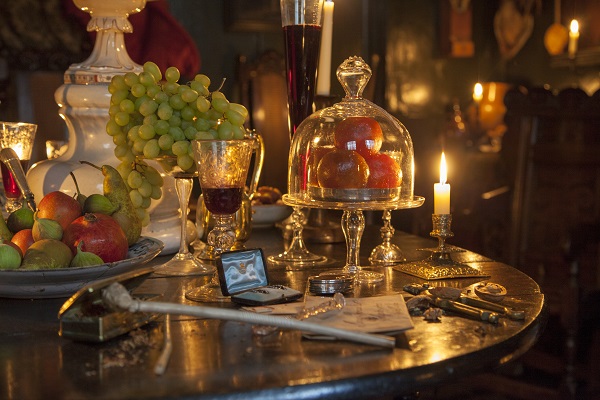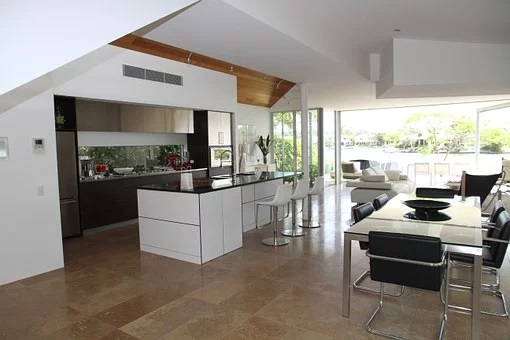Dining room

|
| A dining room in typical Georgian style to celebrate Christmas. |
[edit] Introduction
A dining room is a room in a house, apartment, school etc that is reserved primarily for eating meals (breakfast, lunch or dinner) although other activities may also take place there outside of meal times. As most people like to be seated when they eat, the dining room historically has contained furniture which includes dining tables and chairs.
Generally, throughout history, the buildings of the upper classes tended to have had purpose-built dining rooms (or even banqueting halls) as an integral part of the design: buildings associated with the poor and lower-middle classes usually did not. The only occasion these latter types had dining rooms was when they were added by later occupants in subsequent eras, either by conversion or extension.
[edit] Historical development
Castles, mansions and chambers of government may have had grand dining rooms used for entertaining political, national and internationally prominent figures. Typical of this genre are the grand chambers of government buildings, such as the Banqueting House in London, completed in 1622 by Inigo Jones. Some palaces, such as Hampton Court feature a medieval dining hall with a 270-capacity where for the past 500 years, kings and queens have dined with courtiers and entertained dignitaries.
In Saxon and medieval times, having a dining room would have been the preserve of royalty or the upper classes who may have dined in a great hall. For the majority of the middle classes, given the predominance of the hall house with its single chamber, the functions of eating, sleeping, resting and socialising would have taken place in the same space. Even when the open hearth was enclosed by a brick chimney and a kitchen area appeared at one end of the house, there was unlikely to have been a dedicated room for dining.
It is thought that the habit of nobility taking their meals, not in a great hall, but into the parlour, which provided a more intimate atmosphere, led to the creation of the dining room. This allowed the great hall to be reserved for important occasions.
Formal dining was usually the preserve of the well-to-do and this was certainly the case in Georgian England where many wealthy families threw extravagant dinner parties. Many townhouses would have featured grand rooms for entertaining, with large dining tables and chairs made by leading craftsmen. The dining room (along with an adjacent breakfast room), would usually be on the ground floor of the house, connected to the basement kitchen by a bell or speaking tube.
The early Victorian dining room very much followed the Georgian tradition of being a plainly decorated room with fireplace and surround, rectangular table and chairs, and heavy curtains. Within a few years however, this would give way to the more heavy, ostentatious approach to furniture, fire place, fabrics and decoration that typifies the Victorian era. Only in very large houses would there be a separate dining room. For middle-class families, dining would typically take place in the morning room – so called because it was where breakfast would be taken, but it also functioned as a general dining and family recreation space.
Typically, a separate dining room could be found in larger houses and was used for taking evening meals and for dinner parties. In the Victorian domestic scheme, the dining room (along with the drawing room) were the most important rooms in the house and were where guests were received. In the true Victorian style of amassing clutter, they would contain a liberal quantity of chairs, couches and or sofas, large and small tables (including a dining table and one large centre table), chiffoniers and cabinets. The furniture would be in a great variety of period styles thanks to the rapid development of new manufacturing techniques. The overall taste was for a plush, cosy comfort.
The idea of a separate dining room continued well into the early 20th century, although the Victorian dinner party habit declined after the First World War.
House layouts of the Inter War period still displayed a formal usage of rooms: a standard semi-detached house of the 1920s and 30s typically featured a distinct dining room on the ground floor, facing the garden and behind the street-facing drawing room. It would likely be furnished with a combination of real and reproduction antique furniture, and sport a delft rack: a narrow shelf running around the room at high level for displaying ornaments, china etc.
After the Second World war, the approach to housing layouts became far less formal and saw a desire for a more flexible use of the available space. The formality of houses of the Inter-War period was mostly abandoned and the formal dining room was replaced by an everyday-type of family room.

|
| A contemporary dining area and living space. |
Today, although many houses may not have a dining room, they still may have a fairly loosely-defined dining space, typically fashioned by the demolition of one or two walls to create a large multi-functional space.
[edit] Related articles on Designing Buildings Wiki
Featured articles and news
Latest Build UK Building Safety Regime explainer published
Key elements in one short, now updated document.
UKGBC launch the UK Climate Resilience Roadmap
First guidance of its kind on direct climate impacts for the built environment and how it can adapt.
CLC Health, Safety and Wellbeing Strategy 2025
Launched by the Minister for Industry to look at fatalities on site, improving mental health and other issues.
One of the most impressive Victorian architects. Book review.
Common Assessment Standard now with building safety
New CAS update now includes mandatory building safety questions.
RTPI leader to become new CIOB Chief Executive Officer
Dr Victoria Hills MRTPI, FICE to take over after Caroline Gumble’s departure.
Social and affordable housing, a long term plan for delivery
The “Delivering a Decade of Renewal for Social and Affordable Housing” strategy sets out future path.
A change to adoptive architecture
Effects of global weather warming on architectural detailing, material choice and human interaction.
The proposed publicly owned and backed subsidiary of Homes England, to facilitate new homes.
How big is the problem and what can we do to mitigate the effects?
Overheating guidance and tools for building designers
A number of cool guides to help with the heat.
The UK's Modern Industrial Strategy: A 10 year plan
Previous consultation criticism, current key elements and general support with some persisting reservations.
Building Safety Regulator reforms
New roles, new staff and a new fast track service pave the way for a single construction regulator.
Architectural Technologist CPDs and Communications
CIAT CPD… and how you can do it!
Cooling centres and cool spaces
Managing extreme heat in cities by directing the public to places for heat stress relief and water sources.
Winter gardens: A brief history and warm variations
Extending the season with glass in different forms and terms.
Restoring Great Yarmouth's Winter Gardens
Transforming one of the least sustainable constructions imaginable.






















